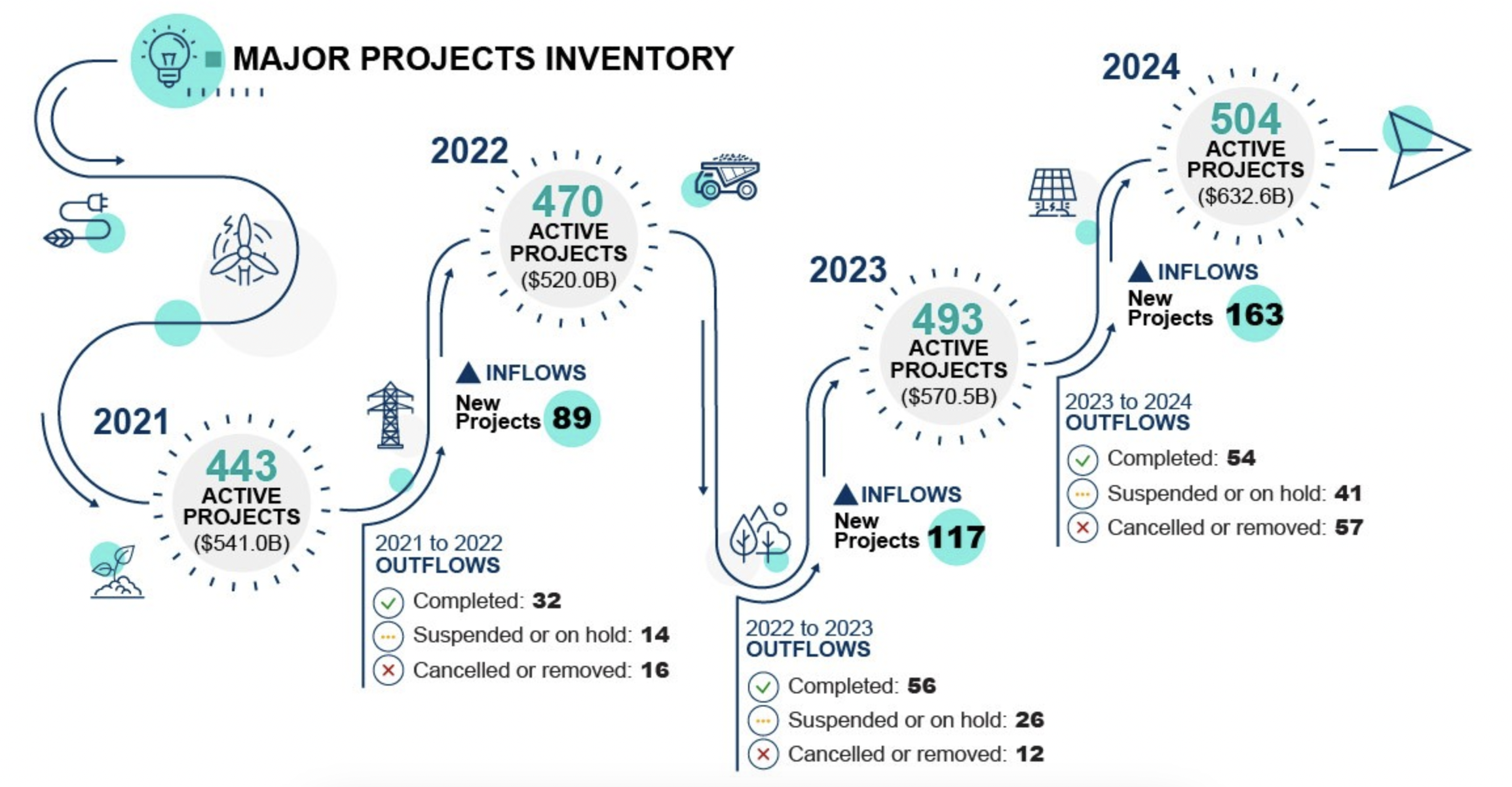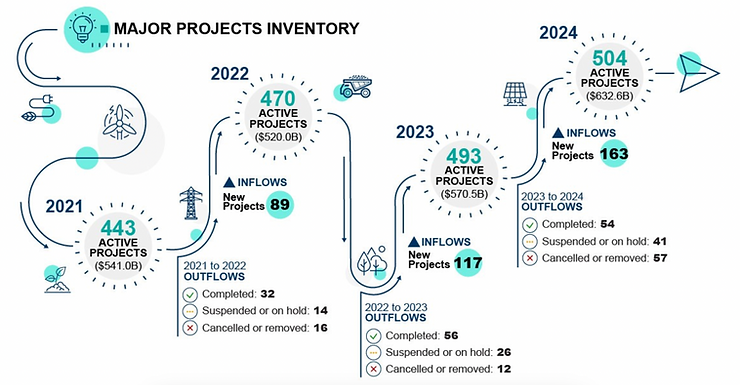
As Canada advances toward net-zero goals, Ontario stands at the epicentre of a massive infrastructure transformation, balancing economic development with environmental stewardship. According to Natural Resources Canada's latest inventory of major projects (2024–2034), Ontario is home to a wide array of resource-related developments, many of which are redefining how we approach transportation, energy, and sustainable urban growth. These projects, valued in the billions, are not just about construction; they symbolise a broader commitment to future-ready infrastructure.

Inflow and Outflow of Projects and Value in the MPI, 2021 to 2024 (NRCanada,2024)
The Ontario Line is one of the most ambitious transit undertakings in the province's history. Spanning nearly 16 kilometres through Toronto’s dense urban core, this rapid transit project aims to reduce congestion and cut travel times for thousands of commuters daily. With 15 planned stations connecting Exhibition Place to the Ontario Science Centre, the Ontario Line will also intersect with other major transit systems like GO Transit and the TTC, creating an integrated network of mobility. Construction is already underway, with full completion expected in the early 2030s. This project reflects Ontario’s shift toward low-emission public transportation, helping to mitigate urban sprawl and pollution.
In tandem with the Ontario Line, the East Harbour Transit Hub is another game-changer. Positioned as a key intermodal station, this hub will support the Ontario Line, GO Transit’s Lakeshore East and Stouffville corridors, and future SmartTrack services. By enhancing regional connectivity and encouraging development in previously underutilised areas, East Harbour exemplifies how infrastructure investments can also serve as urban revitalisation tools.
Meanwhile, Metrolinx’s GO Expansion project (formerly GO RER) continues to electrify and expand existing commuter rail services across Ontario. Electrification of major corridors like Lakeshore West and Kitchener will enable more frequent, reliable service while drastically cutting greenhouse gas emissions. These initiatives aren’t just about improving mobility; they’re helping Ontario transition to a more sustainable and accessible transportation system.
Ontario’s leadership in clean energy is well-established, and in the decade ahead, further reinforcement of that role will be seen. One of the most symbolic transitions is the Nanticoke Solar Facility, built on the former site of North America’s largest coal-fired power plant. The transformation of this site into a 44 MW solar farm represents a powerful shift in provincial energy priorities. It also highlights the collaborative effort between Ontario Power Generation and local Indigenous communities, marking a step forward for inclusive and community-driven development.
Ontario is also maintaining its legacy in nuclear energy, a crucial component of its low-carbon power grid. The refurbishment of the Pickering Nuclear Generating Station’s B units will extend the life of these reactors into the 2030s. While Pickering A units are scheduled for retirement, the investments in Pickering B ensure that nuclear power will remain a steady contributor to Ontario’s electricity supply. Refurbishments of other nuclear facilities, such as Bruce and Darlington, are also ongoing, signifying long-term provincial confidence in nuclear as a reliable clean energy source.
Beyond energy and transportation, Ontario is also investing in infrastructure that supports broader economic and environmental goals. Several mining and mineral processing projects, including those tied to critical minerals like lithium and nickel, are in development across Northern Ontario. These resources are essential to global supply chains for batteries and electric vehicles (EVs), placing Ontario in a strategic position in the clean tech economy. As demand for EVs rises globally, these projects will help secure Canada’s place in the green transition while providing jobs and economic benefits to Indigenous and remote communities.
Additionally, the natural resource projects in Ontario often feature strong commitments to Indigenous partnership and environmental assessment. Many projects include Indigenous equity ownership, benefit-sharing agreements, and skills training programs, ensuring that the energy transition is equitable and inclusive. These collaborations are not only ethical imperatives but also strengthen project success through community engagement and support.
Reference:
Natural Resources Canada. (2024). Major Projects Planned or Under Construction 2024 to 2034 (Cat. No. M2‑24E‑PDF; ISSN 2817‑5646). Government of Canada. https://natural-resources.canada.ca/science‑data/data‑analysis/natural‑resources‑major‑projects‑planned‑under‑construction‑2024‑2034